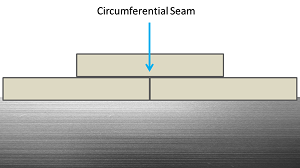In industrial facilities, diesel generators provide supplemental or emergency power to pumps, blowers, elevators and other equipment throughout the facility in the case of unintended power loss. As a result, the temperatures in diesel generator exhaust pipes rise rapidly from ambient to 700°F or higher – there are some manufacturers who have even reported that temperatures in the exhaust piping can approach 1000°F; however, these temperatures are not consistent. Since diesel generators are used as a temporary solution to power loss, they go through many heating and cooling cycles as the generators start, shut-down, and then restart throughout the equipment lifecycle. These heating and cooling cycles require the insulation on the exhaust piping to be able to withstand a repeated and rapid rise and fall in temperature without sacrificing insulating performance.
Diesel generator exhaust piping couples these extreme temperatures with a highly vibrational environment that has a tendency to damage less robust insulations. For example, at such high temperatures mineral wool will experience binder burn-out and silica aerogel will undergo thermal shift, damaging the thermal performance of both insulations. Similarly the rigorous and demanding physical conditions of the diesel generator exhaust piping can physically damage expanded perlite. Depending on the location of the generator exhaust piping (indoors or outdoors), system designers may also need to consider whether corrosion under insulation (CUI) is a variable that needs to be taken into account.
Given these extreme conditions, selecting an insulation with the performance standards necessary to withstand the rigors of a diesel generator exhaust pipe can help optimize performance and lifecycle costs for your system.
Insulation Product Recommendations
Calcium silicate is often specified to insulate diesel generator exhaust piping. The reason for this is that it offers both the high-temperature performance and compressive strength necessary to withstand both the temperatures and vibrations of a diesel generator exhaust pipe. Industrial Insulation Group’s calcium silicate product, Thermo-12® Gold, also contains a corrosion-inhibiting formula, XOX, that can help inhibit CUI in an outdoor application.
An alternative to Thermo-12 Gold is a thin, hydrophobic, microporous blanket called InsulThin™ HT. This blanket insulation has the both the thermal performance and the flexibility necessary to tolerate the extreme vibrations in a diesel generator exhaust pipe. Additionally, it is only millimeters thick, making it ideal for applications where space is limited.
Installation Recommendations
Best practice recommendations for diesel generator exhaust piping suggest using two layers of insulation 1. This allows for the exhaust piping to expand and contract during heat up and cool down without exposing the pipe directly to the surface through gaps in the insulation. In order to apply the layers appropriately, they should be offset from each other both circumferentially and longitudinally such that the outer layer covers the joints of the inner layer.


When installing insulation on long, vertical runs, use insulation support rings to support the weight of the insulation as well as expansion joints. As with all insulations, the system should be covered with a metal jacketing to protect the insulation and add an additional layer of defense against CUI.
If you are looking for additional details or resources on installing insulation on diesel generator exhaust piping, you can check out the additional resources below.
- Industrial Insulation Group I-Spec CSI 3 Part Specification Thermo-12® Gold Calcium Silicate Pipe and Block Insulation (Industrial Insulation Group-502)
- Technical Bulletin: Diesel Generator Exhaust Insulation Selection
- “National Commercial and Industrial Insulation Standards” available from the Midwest Insulation Contractors Assoc., 800-747- 6422, or www.micainsulation.org
- “INIH1000 Hot Insulation Installation Details” available from Process Industry Practices, www.pip.org
